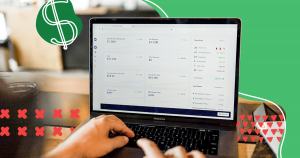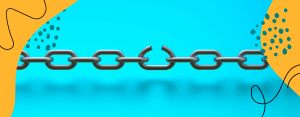For those who work with SaaS Sales, knowing the particularities and characteristics of each audience is essential to stand out.
The way you communicate with the end consumer, for example, should be different from the way you talk to decision-makers in a company.
And that’s why you need to know more about the traits of the B2B SaaS business model.
- How does contracting a service work from one company to another?
- What are the advantages of investing in this business model?
- Which companies are already known for successfully operating in the B2B SaaS market?
In this blog post, we’ll resolve all your questions on this subject. Check out what we will cover:
Download this post by entering your email below
What is B2B SaaS?
B2B SaaS is “business-to-business Software-as-a-Service”. It refers to software offered by a company so that other companies can access the solution’s features and functionalities through an internet connection.
Regardless of the device used, whoever hires a service within this business model can enjoy all the benefits anywhere.
This business model is known for its variety of solutions that can solve the pains of companies from the most different segments.
A CRM platform is a widespread example of B2B SaaS. Another interface widely used by companies is ERPs, which enable more efficient management of a company’s internal processes.
Entering the Digital Marketing universe, B2B SaaS is also very popular for those companies looking to optimize their content management and production for a Content Marketing strategy.
In other words, there are several solutions within this business model, allowing companies to take advantage of all the benefits of a solution simply and practically.

How Does B2B SaaS Work?
B2B SaaS works from cloud-based software distribution.
In practice, it works as follows: a company builds a solution that will help several other companies with their tasks.
Instead of selling access from installing a program on a computer, it is always accessed remotely via the Internet.
Therefore, companies that operate in this business model need to keep servers and databases constantly updated so that their customers can access the software.
The entire transaction is performed remotely and digitally, without the need for installation, which increases the possibility of use by the customer.
B2B SaaS vs B2C SaaS
Naturally, B2B SaaS products have plenty in common with B2C SaaS options.
For example, both require business owners to examine similar types of metrics (like lifetime customer value and churn rate) to determine profitability.
In addition, both are convenient, subscription-based service options that can work for various users.
However, there are several key differences to consider, as well — the differences between selling to other businesses and selling to everyday consumers.
Here’s a closer look at a few of the most important.
Pricing
Although this isn’t necessarily the case across the board, B2B SaaS products tend to be more advanced and, therefore, more expensive than B2C SaaS products.
They’re designed to meet the scalable needs of growing companies and entire teams, so they also need to be more sophisticated.
Language Use
Communication styles often vary drastically between the two options.
For instance, a company selling to another company can (and should) use industry terms and key buzzwords to make a case for their products.
However, that same company would need to communicate in layman’s terms when connecting with and relating to everyday consumers.
Social Media
A company that sells B2B SaaS solutions uses social media much differently than a peer specializing in B2C SaaS instead, and with good reason.
One difference is in the platforms they gravitate toward in the first place.
B2B SaaS companies love professional networks like LinkedIn for the way they support a more serious, business-oriented approach to social media use.
Alternatively, B2C SaaS companies tend to prefer platforms focused on a more entertaining experience, like Pinterest or Instagram.
Some large, very versatile platforms — like Twitter and Facebook — are good fits for both types of companies.
Relationships
Although everyday consumers do like to feel they have a personal relationship with the brands they buy from, the average customer-brand relationship with a B2C SaaS company is lower maintenance.
B2B relationships, on the other hand, require a lot of depth and nurturing, especially over time.
B2B SaaS Marketing vs Traditional Marketing
Naturally, the differences between B2C and B2B SaaS companies don’t stop at their products or the way they’re run.
The marketing process is also very different for B2B.
The average lead is typically on a very different buyer’s journey, and the company’s marketing strategies need to reflect that.
Here are some key differences to keep in mind regarding marketing success.
Longer Buyer’s Journeys
B2B customers, especially those looking into SaaS options, take longer to make their way through a sales funnel than a B2C consumer.
To begin with, they do more research throughout the process to evaluate their options.
Their overall journey also involves more steps and includes more one-to-one involvement with sales reps. B2B SaaS marketing tactics take all these factors into consideration.
Rarer Impulse Purchases
Although B2B SaaS impulse purchases occasionally happen, they’re very rare.
For one thing, the process of choosing the right fit for a specific company is complicated, as well as expensive in many cases.
Successful B2B SaaS marketing campaigns make room for more different campaigns and more potential touchpoints with leads.
Most B2B SaaS customers also require more personal nurturing from sales reps throughout their journey.
Retention Rate
Because the process of choosing the right solution and integrating it into their business function is so time-consuming and complex, most B2B SaaS clients tend to stick with the products they choose.
They’re not constantly on the lookout for a better deal, nor are they likely to evaluate more than one option at a time.
So long as they’re happy with the service and everyone else on the team agrees, B2B SaaS clients usually stick around.
What are the Advantages of this Business Model?
Here is a list with a few of them:
Practicality for use
One of the great benefits of this business model is the ease and practicality to companies.
As no installation is required, it becomes much easier to use it in your day-to-day life.
Just access the software through your browser from any device, type your access credentials, and you can use all the resources.
Very valuable for smaller teams that are not as technically savvy, B2B SaaS offers convenience for use.
No need for significant investments
Another critical point of the B2B SaaS model is the possibility of cost reduction.
These cloud-based software products are usually much cheaper than the traditional version.
This is because it runs on a single infrastructure, as it becomes possible to make changes for all customers at once, without having to face too many problems with it (for example, software maintenance).
This reduction in costs for the company offering the service is also reflected in the price charged in the market. Thus, B2B SaaS implies a cheaper operation for all parties involved.
Cost and Revenue Predictability
An essential feature of the B2B SaaS model is the predictability of costs and revenue.
On one hand, the client subscribes to a monthly, semi-annually or annual subscription and has an exact forecast of how much will need to be invested over that period.
This is a detail that can help a lot in the management of your financial resources and in the best use of your budget.
At the same time, companies that develop SaaS for other companies can plan their financial plans more precisely, thanks to the recurring payments of the subscription systems.
With this more significant control of resources, it is easier to identify the need for new investments or ensure timely improvements.
Upgrading and enhancements are simpler to do
Perhaps the most significant advantage of a B2B SaaS is the possibility of upgrading without losing time on the job.
In a moment marked by the constant search for greater productivity, the updates made to the contract software do not demand so much time from customers.
This greater practicality is also highly valued within this business model.
Another important topic that this model provides is more comprehensive support. After all, it is natural that questions arise during the use of the software.
The advantage is that B2B SaaS solutions usually offer 24-hour support services seven days a week since users’ experience increases.
The possibility of free trials for a certain period is another highlight.
Flexibility
Since it is an entirely remote working model, flexibility is another critical benefit of B2B SaaS.
A small business that started its subscription plan with a more straightforward service can gradually scale up the services contracted.
Since the solutions are more customizable, there are fewer limits, making this an ideal option for growing brands.
The possibility of customizing what is hired is also another essential differential since it increases the reach of a solution.
Suppose that a software previously had a limited target audience. In that case, the B2B SaaS model allows the functionalities to be reduced or expanded, always according to each client’s amount paid and needs.
B2B SaaS Marketing: Best Practices to Know
Most of the marketing advice you see out there is geared toward B2C companies and fails to consider the unique B2B buyer’s journey.
Here are a few best practices to keep in mind as you set up a winning B2B sales model of your own.
1. Make sure your product pages are thorough
B2B customers, especially those shopping around for SaaS options, really need to know the shot when it comes to what your product can do.
They need all the details on how your software works, why it’s worth a closer look, and especially how it’s better than the other solutions out there.
Your product pages need to cater to this need in a big way.
In addition to covering the facts, make sure you give your leads an inside look at the product itself.
Include screenshots of the interface, mock-ups, and similarly illustrative options to help your marketing hit home.
2. Tailor messaging for your target audience
When you’re in B2B SaaS marketing, you’re not looking to reach just anyone with your marketing.
Instead, you want to connect with high-level entities at the companies you sell to — the decision-makers who’ll ultimately be the ones finalizing that purchase.
PPC ads are one highly effective way to do this, as is content marketing.
Just make sure you focus your content on the specific problems your options can solve for those companies.
3. Entice leads with a free consultation
Remember, plenty of personal attention is the key to successful B2B SaaS marketing, so the sooner you can get your lead to make contact with a rep, the better.
Often, sweetening the deal with a free initial consultation is a game-changer, as interested prospects know they have nothing to lose.
Many B2B companies also see a lot of success with free trial offers, especially those that include extended demos.
So give your leads a pleasant taste of what they’ll be getting if they take that next step.
4. Assign an account manager to each prospect
Once you’ve successfully gotten a sales prospect to make contact with your company, start actively nurturing that connection right away.
Assign an account manager or dedicated sales rep to each of your prospective customers, and have them reach out. If possible, set up a call to address any questions or concerns.
It’s also essential to keep the email correspondence going. A well-cultivated autoresponder setup will be helpful here, but don’t rely too heavily on automated solutions.
Account managers should personally follow up with leads at suitable intervals, especially at the end of a trial or demo period.
Offer discounts and other perks to help nudge promising leads toward a purchase. Sometimes all someone who’s already interested needs is a little push.
5. Keep customers engaged after purchase
Successful B2B SaaS marketing doesn’t stop once a rep closes a sale.
Don’t simply assume that your clients are satisfied and can take the initiative themselves if they have more questions. Actively follow up with solid re-engagement marketing.
Check in with customers from time to time and let them know what’s new with your product. Keep them in the know about new features you introduce.
Also, let them know what’s available should they upgrade to a higher service tier or purchase a companion product.
Consider introducing a referral program, as well, so your existing clients can take advantage of incentives for bringing colleagues and peers on board.
B2B SaaS KPIs to Track
As with any ongoing marketing campaign, getting a B2B SaaS campaign set up is only part of the equation.
You won’t really know whether you’re successful unless you carefully track results and crucial key performance indicators (KPIs).
Here are a few that definitely belong on your radar.
Customer Acquisition Cost (CAC)
This metric is exactly what it sounds like — the average investment it takes to bring each new customer on board. Compare this to corresponding profits to ensure a good ongoing return on your original investment.
Customer Lifetime Value (CLTV)
This metric determines the average worth of each customer throughout the duration of your business relationship. For instance, a customer who stays with you for a year and spends $100 each month on their subscription has a CLTV of $1200, not $100.
Churn Rates
A customer who churns is one who cancels their subscription at the end of a membership period or otherwise elects not to renew.
Your churn rate refers to the overall percentage of customers who did this during a specified period versus the percentage that didn’t.
To determine the churn rate attached to a set period, divide the number of churned customers by the total number of new customers you brought on board. Then, multiply it by 100, and you’ve got your churn rate.
Monthly Recurring Revenue (MRR)
Naturally, budgeting is an integral part of any successful marketing campaign, B2B or otherwise, and MRR is one important metric to look at when assessing yours.
Your monthly recurring revenue is the average amount your company can expect to bring in over a typical month.
Look to MRR to determine and adjust your ongoing budgets, as well as assess whether your business is growing consistently over time.
Annual Recurring Revenue (ARR)
Like MRR, annual recurring revenue is crucial for monitoring the profitability of your business, especially over the long haul.
It’s, of course, the amount you expect to bring in over a whole year.
Keeping careful track of your KPIs and adjusting accordingly is the best way to make sure your business not only becomes profitable but stays that way on an ongoing basis.
How do your numbers measure up against your business goals? What can you tweak about your ongoing campaigns to make them better next time?
Examples of B2B SaaS Companies
Here are some prime examples of how B2B SaaS is already present in the market!
#1: Google
When talking about solutions in the digital environment, it is natural to always think of Google, isn’t it?
Although the search engine is the company’s best-known platform, it also provides several solutions that fit into the B2B SaaS model and that you have probably used a few times already.
After all, you don’t need to install any software to send an e-mail, right? Anyone from any place or device can access Gmail.
The same goes for other Google features such as Drive, which allows the storage of documents in the cloud, Forms, focused on forms and surveys, or Docs, the version of Microsoft Word produced by Google and in SaaS format.
In other words, practically the entire company’s product portfolio is based on this business model.
#2: Dropbox
Another classic example of digital transformation and B2B SaaS advancements is Dropbox.
The cloud storage company has its strategies aimed at small businesses and end consumers as well.
The offering is straightforward: space where customers can store a range of documents and files in the software to share with others or access anywhere, without saving to hardware.
#3: MailChimp
Email marketing is a strategy widely used by marketing professionals who want to create a closer relationship with their audience.
And nothing better than to count on a fully customizable and flexible solution, such as MailChimp.
The company’s customers can configure their entire sending flow, customize messages, control the efficiency of strategies, and increase the chances of success of their campaigns.
#4: HubSpot
Marketing and sales strategies can also be used from a B2B SaaS perspective, and the best example is HubSpot.
With a complete platform focused on customer relationship management, the company allows other companies to optimize their processes for attracting, nurturing, and contacting leads and potential customers.
In addition, HubSpot has numerous solutions based on the same business model but focuses on solutions for marketing teams.
And all this is done in a scalable, flexible and customized way thanks to the SaaS model.
Wrap Up: B2B SaaS is the Business Model of the Present and the Future
Digital transformation has allowed more access to a variety of technological resources to boost the growth of this business model.
More companies are finding complementary solutions to their internal processes through B2B SaaS.
With the accelerating evolution of technology, the trend is that this business model is the present and especially the future.
The B2B SaaS model offers a variety of projects, allowing different companies to improve their processes and even business models, with a simplified and practical interface.
Whether to better manage the relationship with your customers or to boost your team’s productivity, B2B SaaS will enhance your team’s workflow.
How about getting to know some examples of B2B SaaS that can contribute to your marketing strategies?
Continue on our blog to check out 7 Tools for B2B Content Marketing to try!









